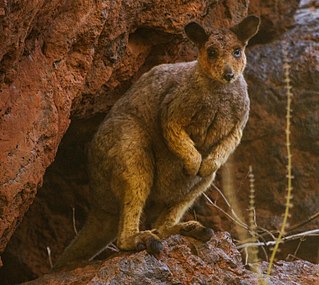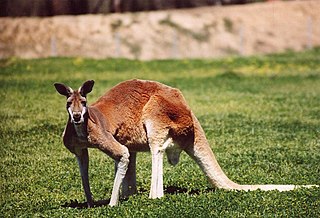
Mungo National Park is a protected national park that is located in south-western New South Wales, in eastern Australia. The 110,967-hectare (274,210-acre) national park is situated approximately 875 kilometres (544 mi) west of Sydney in the Balranald Shire. Mungo National Park is the traditional meeting place of the Muthi Muthi, Nyiampaar and Barkinji Aboriginal Nations. People are no longer able to climb the sand dunes by themselves as stricter rules have been enforced, all visitors groups need to be accompanied by an accredited tour guide to access the sand dunes.

Conservation in Australia is an issue of state and federal policy. Australia is one of the most biologically diverse countries in the world, with a large portion of species endemic to Australia. Preserving this wealth of biodiversity is important for future generations.

The brush-tailed rock-wallaby or small-eared rock-wallaby is a kind of wallaby, one of several rock-wallabies in the genus Petrogale. It inhabits rock piles and cliff lines along the Great Dividing Range from about 100 km north-west of Brisbane to northern Victoria, in vegetation ranging from rainforest to dry sclerophyl forests. Populations have declined seriously in the south and west of its range, but it remains locally common in northern New South Wales and southern Queensland. However, due to a large bushfire event in South-East Australia around 70% of all the wallaby's habitat has been lost as of January 2020.

The bridled nail-tail wallaby, also known as the bridled nail-tailed wallaby, bridled nailtail wallaby, bridled wallaby, merrin, and flashjack, is a vulnerable species of macropod. It is a small wallaby found in three isolated areas in Queensland, Australia, and whose population is declining. In early 2019 the total population of the species was estimated to be fewer than 500 mature individuals in the wild and 2285 in captivity.

Conservation Volunteers Australia is an Australian not-for-profit conservation organisation that attracts and co-ordinates volunteers for environmental restoration projects.

The Australian Conservation Foundation (ACF) is Australia's national environmental organisation, launched in 1965 in response to a proposal by the World Wide Fund for Nature for a more co-ordinated approach to sustainability.

The National Wildlife Federation (NWF) is the United States' largest private, nonprofit conservation education and advocacy organization, with over six million members and supporters, and 51 state and territorial affiliated organizations.

WIRES Wildlife Rescue is the largest wildlife rescue & rehabilitation charity in Australia. It is a non-profit organisation providing rescue and rehabilitation for all native Australian fauna. All animal rescuers and carers are volunteers. It is funded by public donations and operates throughout the most populous Australian state, New South Wales.

The yellow-footed rock-wallaby, formerly known as the ring-tailed rock-wallaby, is a member of the macropod family.

The rock-wallabies are the wallabies of the genus Petrogale.
The Australian Orangutan Project t/a The Orangutan Project (TOP) is a non-profit registered Australian environmental organisation established in 1998, which raises funds to support the conservation and protection of orangutans and the preservation and rehabilitation of their forest habitats, which are primarily located in Indonesia. It undertakes this work by supporting a range of other organisations working in the field, such as the Borneo Orangutan Survival Foundation (BOS), the Orangutan Foundation International, founded by Dr Birute Galdikas and the Orangutan Foundation.

The Australian Wildlife Conservancy (AWC) is an Australian independent, nonprofit organisation, working to conserve threatened wildlife and ecosystems in Australia. This is principally achieved through the acquisition of extensive areas of land on which to establish conservation reserves ("sanctuaries") or by entering into partnerships with government, Indigenous groups, and private landholders to manage landscapes for effective conservation. AWC is the largest private owner and manager of land for conservation in Australia, currently managing 31 sanctuaries and partnership sites for wildlife conservation that cover over 6.5 million hectares of land across Australia.
Wildlife Australia Fund, Inc. is a United States based international charitable organization established for the conservation, research and restoration of the environment. It was established and founded by an American and is supported by Australian expatriates in New York. It is established to assist in the acquisition of land in Australia for the conservation of threatened species and ecosystems, conducting research into conservation and biodiversity in Australia and undertaking public education regarding Australian wildlife conservation. It encourages active participation worldwide to help restore the balance to the delicate ecosystem of Australia. Funding comes from tax-deductible donations from the public.

The kangaroo industry in Australia is based on the regulated harvesting of the large, abundant species of kangaroos. Limitation of the numbers of kangaroo can have environmental benefits, and is a way of meat production that does not involve intensive animal farming.

Feral goats are an invasive animal species in Australia. First arriving in the 18th century with European settlers, feral goat populations originated from escaped domestic individuals. Today, feral goats are found across Australia, where they cause economic and environmental damage through overgrazing and competition with livestock and native marsupials.

The Yathong Nature Reserve is a protected nature reserve that is also a nationally and internationally recognized biosphere situated in the central-western region of New South Wales, in eastern Australia. The 107,240-hectare (265,000-acre) reserve was listed by UNESCO in 1977 as a Biosphere Reserve under the Man and the Biosphere Programme (MAB). The reserve is significant for its biodiversity in both native plant and animal species. Cultural heritage and historical grazing activities add to the significance of this site as a conservation area.
Boginderra Hills Nature Reserve is a protected nature reserve situated to the north of Temora, located in the Riverina region of New South Wales in eastern Australia. It has an area of 756 hectares.
The David G. Stead Memorial Wildlife Research Foundation of Australia is an Australian non-profit organisation that aims to promote conservation and environment advocacy and education. Established in 1963 as a memorial to David George Stead, a pioneer conservationist and marine biologist throughout the early 20th century, the Stead Foundation is a project-based organisation. Its inaugural and most enduring project was the establishment of the Wirrimbirra Sanctuary, gifted to the National Trust of Australia in 1965.














